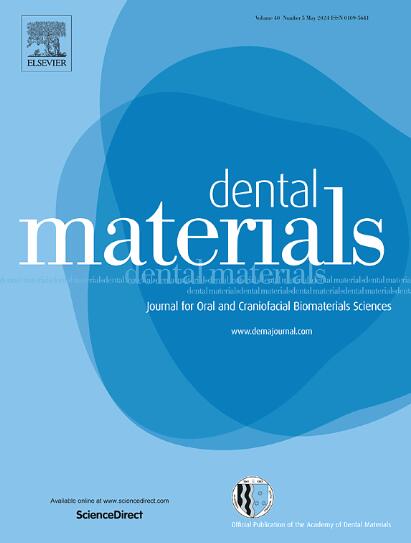种植体基台与牙根之间是否可能发生电偶腐蚀?一项模拟健康和炎症种植体周围条件和F阴离子的实验研究。
IF 4.6
1区 医学
Q1 DENTISTRY, ORAL SURGERY & MEDICINE
引用次数: 0
摘要
目的:评估健康和炎症状态以及F阴离子的存在对市产钛种植体根表面与钛基之间电偶的影响。材料和方法:将8对3对牙根-基对(BEGO, MIS, NOBEL)分别暴露于模拟健康和炎症状态的中性(pH=7.4) (HE)和酸性(pH=4.0) (IN)磷酸盐缓冲溶液(PBS)中。为了模拟牙膏中常用的F阴离子的存在,在模拟健康状态(HEF)和炎症状态(INF)的两种溶液中分别加入3.12 g NaF。记录48 h的电位差并取平均值。体视显微镜下观察基牙和根的物理外观。利用扫描电子显微镜和x射线能谱(SEM/EDX)对所研究材料进行表征,并对电激测试前后的表面进行了比较。结果:所有基牙均由Ti- 6al - 4v合金和MIS系统根部组成,而BEG和NOB由Ti组成。电流测试前后表面形貌没有差异,而EDX分析显示,在INF条件下测试后,MIS基台表面仅存在Na和F。在HE、IN和HEF条件下,所有测试组的电位差都可以忽略不计,低于引发电偶腐蚀的标称阈值。在INF条件下,同样适用于BEG和MIS,而NOB的平均电位差值为-273 mV,高于电流作用的标称阈值。在INF条件下,只有MIS基台的颜色由黄色变为蓝色。结论和临床意义:BEG和MIS植入系统在所有测试条件下都不容易发生电偶腐蚀。发现在F阴离子存在的炎性种植体周围条件下,NOB容易受到电偶腐蚀。即使在钛基植入物组件之间也可能发生电反应。本文章由计算机程序翻译,如有差异,请以英文原文为准。
Is galvanic corrosion between implant abutments and roots a possible scenario? An experimental study under simulated healthy and inflammatory peri-implant conditions and F anions
Purpose
To assess the effect of healthy and inflammatory conditions and the presence of F anions on the galvanic coupling between the root surface and titanium abutments of commercially available titanium implants
Materials and methods
Eight pairs of three dental root-abutment couples (BEGO, MIS, NOBEL) were exposed to a neutral (pH=7.4) (HE) and an acidic (pH=4.0) (IN) phosphate buffer solution (PBS) simulating healthy and inflammatory conditions respectively. In order to simulate the presence of F anions, which is commonly used in toothpastes, 3.12 gr of NaF was added in both solutions simulating healthy conditions (HEF) and inflammatoy conditions (INF) with the presence of F anions respectively. The galvanic potential difference was recorded for 48 h and averaged. Physical appearance of abutment and roots were tested under a stereomicroscope. Scanning electron microscopy and X-ray energy dispersive spectroscopy (SEM/EDX) was used to characterize the materials under reseach and compare the surfaces before and after galvanic testing.
Results
All abutments are composed of Ti-6Al-4V alloy along with root of MIS system, while BEG and NOB are made of Ti according to the SEM/EDX analysis. No differences were identified in surface morphology before and after galvanic testing, while EDX analysis revealed only the presence of Na and F on the surface of MIS abutments after testing in INF conditions. All groups tested showed negligible potential difference and below the nominal threshold for triggering galvanic corrosion under HE, IN and HEF conditions. The same applies for BEG and MIS under INF conditions, while NOB presented an average potential difference value of −273 mV, which is above nominal thresshold for galvanic action. Only MIS abutment showed a color change from yellow to blue under INF conditions.
Conclusions and clinical implications
BEG and MIS implant systems are not prone to galvanic corrosion in all conditions tested. NOB was found vulnerable to galvanic corrosion under inflammatory peri-implant conditions in the presence of F anions. Galvanic reactions is a possible scenario even between Ti base implant components.
求助全文
通过发布文献求助,成功后即可免费获取论文全文。
去求助
来源期刊

Dental Materials
工程技术-材料科学:生物材料
CiteScore
9.80
自引率
10.00%
发文量
290
审稿时长
67 days
期刊介绍:
Dental Materials publishes original research, review articles, and short communications.
Academy of Dental Materials members click here to register for free access to Dental Materials online.
The principal aim of Dental Materials is to promote rapid communication of scientific information between academia, industry, and the dental practitioner. Original Manuscripts on clinical and laboratory research of basic and applied character which focus on the properties or performance of dental materials or the reaction of host tissues to materials are given priority publication. Other acceptable topics include application technology in clinical dentistry and dental laboratory technology.
Comprehensive reviews and editorial commentaries on pertinent subjects will be considered.
 求助内容:
求助内容: 应助结果提醒方式:
应助结果提醒方式:


